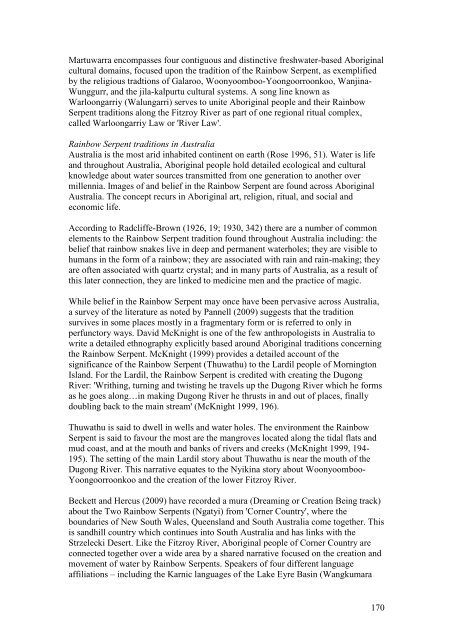WEST KIMBERLEY PLACE REPORT - Department of Sustainability ...
WEST KIMBERLEY PLACE REPORT - Department of Sustainability ...
WEST KIMBERLEY PLACE REPORT - Department of Sustainability ...
You also want an ePaper? Increase the reach of your titles
YUMPU automatically turns print PDFs into web optimized ePapers that Google loves.
Martuwarra encompasses four contiguous and distinctive freshwater-based Aboriginal<br />
cultural domains, focused upon the tradition <strong>of</strong> the Rainbow Serpent, as exemplified<br />
by the religious tradtions <strong>of</strong> Galaroo, Woonyoomboo-Yoongoorroonkoo, Wanjina-<br />
Wunggurr, and the jila-kalpurtu cultural systems. A song line known as<br />
Warloongarriy (Walungarri) serves to unite Aboriginal people and their Rainbow<br />
Serpent traditions along the Fitzroy River as part <strong>of</strong> one regional ritual complex,<br />
called Warloongarriy Law or 'River Law'.<br />
Rainbow Serpent traditions in Australia<br />
Australia is the most arid inhabited continent on earth (Rose 1996, 51). Water is life<br />
and throughout Australia, Aboriginal people hold detailed ecological and cultural<br />
knowledge about water sources transmitted from one generation to another over<br />
millennia. Images <strong>of</strong> and belief in the Rainbow Serpent are found across Aboriginal<br />
Australia. The concept recurs in Aboriginal art, religion, ritual, and social and<br />
economic life.<br />
According to Radcliffe-Brown (1926, 19; 1930, 342) there are a number <strong>of</strong> common<br />
elements to the Rainbow Serpent tradition found throughout Australia including: the<br />
belief that rainbow snakes live in deep and permanent waterholes; they are visible to<br />
humans in the form <strong>of</strong> a rainbow; they are associated with rain and rain-making; they<br />
are <strong>of</strong>ten associated with quartz crystal; and in many parts <strong>of</strong> Australia, as a result <strong>of</strong><br />
this later connection, they are linked to medicine men and the practice <strong>of</strong> magic.<br />
While belief in the Rainbow Serpent may once have been pervasive across Australia,<br />
a survey <strong>of</strong> the literature as noted by Pannell (2009) suggests that the tradition<br />
survives in some places mostly in a fragmentary form or is referred to only in<br />
perfunctory ways. David McKnight is one <strong>of</strong> the few anthropologists in Australia to<br />
write a detailed ethnography explicitly based around Aboriginal traditions concerning<br />
the Rainbow Serpent. McKnight (1999) provides a detailed account <strong>of</strong> the<br />
significance <strong>of</strong> the Rainbow Serpent (Thuwathu) to the Lardil people <strong>of</strong> Mornington<br />
Island. For the Lardil, the Rainbow Serpent is credited with creating the Dugong<br />
River: 'Writhing, turning and twisting he travels up the Dugong River which he forms<br />
as he goes along…in making Dugong River he thrusts in and out <strong>of</strong> places, finally<br />
doubling back to the main stream' (McKnight 1999, 196).<br />
Thuwathu is said to dwell in wells and water holes. The environment the Rainbow<br />
Serpent is said to favour the most are the mangroves located along the tidal flats and<br />
mud coast, and at the mouth and banks <strong>of</strong> rivers and creeks (McKnight 1999, 194-<br />
195). The setting <strong>of</strong> the main Lardil story about Thuwathu is near the mouth <strong>of</strong> the<br />
Dugong River. This narrative equates to the Nyikina story about Woonyoomboo-<br />
Yoongoorroonkoo and the creation <strong>of</strong> the lower Fitzroy River.<br />
Beckett and Hercus (2009) have recorded a mura (Dreaming or Creation Being track)<br />
about the Two Rainbow Serpents (Ngatyi) from 'Corner Country', where the<br />
boundaries <strong>of</strong> New South Wales, Queensland and South Australia come together. This<br />
is sandhill country which continues into South Australia and has links with the<br />
Strzelecki Desert. Like the Fitzroy River, Aboriginal people <strong>of</strong> Corner Country are<br />
connected together over a wide area by a shared narrative focused on the creation and<br />
movement <strong>of</strong> water by Rainbow Serpents. Speakers <strong>of</strong> four different language<br />
affiliations – including the Karnic languages <strong>of</strong> the Lake Eyre Basin (Wangkumara<br />
170
















